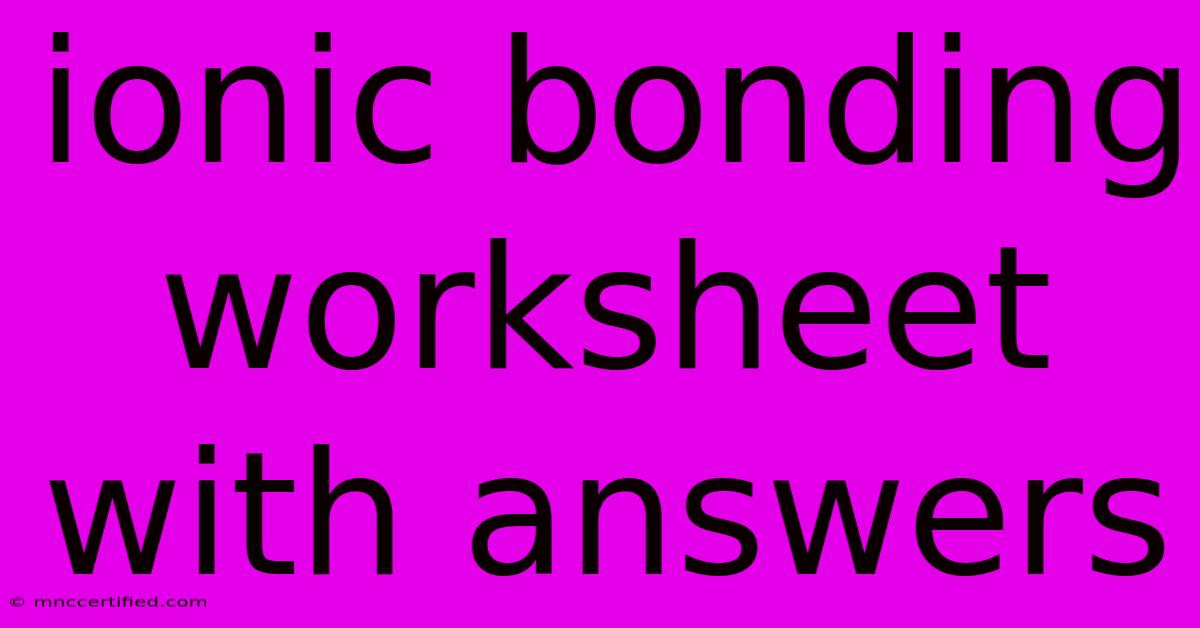Ionic Bonding Worksheet With Answers

Table of Contents
Master Ionic Bonding with this Worksheet and Answers
Ionic bonding is a fundamental concept in chemistry, and understanding it is crucial for comprehending the behavior of various compounds. This worksheet provides a comprehensive exploration of ionic bonding, complete with answers to help you solidify your understanding.
What is Ionic Bonding?
Ionic bonding is a type of chemical bond formed between oppositely charged ions. These ions form when atoms gain or lose electrons, resulting in a positively charged cation or a negatively charged anion. The strong electrostatic attraction between these ions holds them together, creating a stable ionic compound.
Key Concepts to Remember:
- Electronegativity: The ability of an atom to attract electrons in a chemical bond. Elements with high electronegativity tend to gain electrons and form anions, while those with low electronegativity tend to lose electrons and form cations.
- Octet Rule: Atoms tend to gain, lose, or share electrons to achieve a stable configuration with eight electrons in their outermost shell (valence shell).
- Ionic Compounds: Compounds formed through ionic bonding typically have high melting and boiling points, are good conductors of electricity when dissolved in water, and are often crystalline in structure.
Let's Dive into the Worksheet:
Section 1: Understanding Ionic Bonds
1. Define the following terms:
- Ionic bond: A chemical bond formed between oppositely charged ions due to electrostatic attraction.
- Cation: A positively charged ion formed when an atom loses electrons.
- Anion: A negatively charged ion formed when an atom gains electrons.
2. Explain how an ionic bond is formed using the example of sodium chloride (NaCl).
- Sodium (Na) has one valence electron, while chlorine (Cl) has seven.
- Sodium loses its valence electron to become a positively charged sodium ion (Na+).
- Chlorine gains an electron to become a negatively charged chloride ion (Cl-).
- The oppositely charged ions are attracted to each other, forming an ionic bond and creating the compound sodium chloride (NaCl).
3. Identify the cation and anion in the following ionic compounds:
- KBr: K+ (cation) and Br- (anion)
- CaO: Ca2+ (cation) and O2- (anion)
- Al2O3: Al3+ (cation) and O2- (anion)
Section 2: Drawing Lewis Dot Structures
1. Draw Lewis dot structures for the following atoms:
- Lithium (Li): Li.
- Oxygen (O): ..O..
- Nitrogen (N): .N.
- Fluorine (F): ..F.
2. Use Lewis dot structures to represent the formation of ionic bonds in the following compounds:
- Lithium fluoride (LiF): Li+ [F]-
- Magnesium oxide (MgO): Mg2+ [O]2-
- Calcium chloride (CaCl2): Ca2+ [Cl]- [Cl]-
Section 3: Properties of Ionic Compounds
1. Explain why ionic compounds have high melting and boiling points.
Ionic compounds have strong electrostatic attractions between the oppositely charged ions. This strong attraction requires a large amount of energy to overcome, resulting in high melting and boiling points.
2. Why are ionic compounds good conductors of electricity when dissolved in water?
When ionic compounds dissolve in water, the ions are freed from their crystal lattice and can move freely. This allows the ions to carry electrical charge, making the solution a good conductor of electricity.
3. Describe the typical crystal structure of ionic compounds.
Ionic compounds typically form a regular, three-dimensional crystal lattice where cations and anions are arranged in a specific repeating pattern to minimize electrostatic repulsion and maximize attraction.
Answer Key:
This worksheet provides a foundation for understanding ionic bonding. The provided answers can serve as a guide to check your work and further solidify your comprehension.
Tips for Success:
- Practice makes perfect! Work through multiple examples to reinforce your understanding of ionic bonding.
- Visualize the process. Drawing Lewis dot structures and diagrams can help you visualize the electron transfer and bond formation.
- Connect concepts. Relate ionic bonding to other concepts like electronegativity and the octet rule.
By mastering the concepts presented in this worksheet, you will be well-equipped to understand the fascinating world of ionic compounds and their diverse applications in chemistry and beyond!

Thank you for visiting our website wich cover about Ionic Bonding Worksheet With Answers. We hope the information provided has been useful to you. Feel free to contact us if you have any questions or need further assistance. See you next time and dont miss to bookmark.
Featured Posts
-
Great Florida Insurance Pace Florida
Nov 11, 2024
-
Boones Overhead Flip 2024 Event Highlight
Nov 11, 2024
-
Iowa Insurance License Practice Test
Nov 11, 2024
-
Bosa Returns Active For Week 10 Game
Nov 11, 2024
-
Draymond Receives Tech For Unsportsmanlike Conduct
Nov 11, 2024